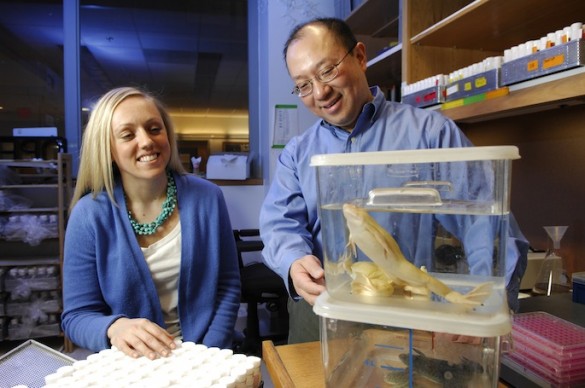“That could either be a total artifact or it could be the discovery of the century.”

A few years ago, Alison Hanson, a student in Vanderbilt’s Medical Scientist Training Program, was invited to have lunch with a visiting Nobel laureate, Aaron Ciechanover. Hanson was working on her dissertation research at the time, and she described some interesting findings to Ciechanover.
“He said, ‘That could either be a total artifact or it could be the discovery of the century,’” Hanson recalled.
It wasn’t a total artifact.
Hanson, her mentor Ethan Lee, associate professor of cell and developmental biology, and colleagues have discovered a new molecular participant in the Wnt (pronounced “wint”) signaling pathway, which plays important roles in cell growth, development and cancer.
The investigators report in the March 9 issue of Molecular Cell, that XIAP, a protein that inhibits cell death and has been the focus of recent anti-cancer drug development, promotes Wnt signaling. The findings suggest that targeting XIAP’s role in Wnt signaling — in addition to its role in cell death — may produce even better cancer therapeutics.
Wnt signaling mutations occur in most non-inherited colon cancers
Mutations that activate the Wnt signaling pathway occur in more than 90 percent of sporadic (non-inherited) colorectal cancers, and are thought to play a role in breast, liver and other major cancers. Blocking the Wnt pathway has been a desirable therapeutic target, but its complexity has made it difficult to find “druggable” targets, said Lee, associate professor of Cell and Developmental Biology.
Lee and his colleagues are interested in understanding how the Wnt signaling pathway works – with the possibility that their discoveries may identify new anti-cancer targets.
First believed to be a fluke
They focused on enzymes that might regulate the pathway, called ubiquitin ligases (proteins that add a ubiquitin “tag” to mark other proteins for degradation). Using fruit fly genes and cells, Hanson developed a screening strategy to identify ubiquitin ligases involved in Wnt signaling.
Her screen produced the strongest signal for the fruit fly equivalent of XIAP (called DIAP-1) — eliminating DIAP-1 in fruit fly cells blocked Wingless (the fruit fly equivalent of Wnt) signaling. But others had shown that eliminating DIAP-1 causes fruit fly cells to die, so Hanson and Lee suspected that the low Wnt signaling was an artifact and they moved on to other studies.
More than a year later, Hanson decided to follow up on the shelved findings. She found that reducing XIAP levels in human cells — both normal cells and colorectal cancer cells — inhibited Wnt signaling. Then she turned to frog embryos, where loss of early Wnt signaling results in headless embryos and too much early Wnt signaling causes two heads to form.
She found that knocking down XIAP resulted in frog embryos with no heads and injecting extra XIAP caused frog embryos to develop two heads.
“I was screaming,” Hanson recalled laughing. “That’s not a fluke. It’s nearly impossible to get a second axis (another head) as an artifact.”
Feeling certain that XIAP really was involved in Wnt signaling, Hanson turned to “the harder part of the project: figuring out how and why it was required for Wnt signaling,” she said.
Help from a protein called “Groucho”
The investigators discovered that XIAP acts in the nucleus, where it adds ubiquitin to a protein called Groucho. This releases Groucho’s inhibitory hold and allows the Wnt pathway to activate gene expression.
“We think of Groucho as a safety switch,” Lee said. “Because the Wnt pathway is so important in growth and proliferation — and because when it’s active it can lead to cancer — you would want something to keep it turned off, to make sure it doesn’t get turned on accidentally. That’s Groucho.
“XIAP then removes the Groucho safety switch and lets beta-catenin turn on the system.”
XIAP was already the focus of anti-cancer drug development because it blocks cell death (inhibiting XIAP should induce cell death). Most of the ongoing efforts have targeted the region of XIAP that blocks cell death, which is different from the region involved in Wnt signaling, Lee said.
Targeting both regions may be a way to develop particularly effective anti-cancer agents, he said. “[rquote]Theoretically, drugs that inhibit both of XIAP’s activities would promote cell death and block cell growth and proliferation.”[/rquote]
Lee and his colleagues are pursuing other ubiquitin ligases and related compounds for their roles in regulating Wnt signaling.
Other contributors to the studies included research associate Heather Wallace, doctoral candidate Tanner Freeman, R. Daniel Beauchamp, J. C. Foshee Distinguished Professor of Surgical Sciences, and Laura Lee, associate professor of cell and developmental biology. The research was supported by grants from the American Cancer Society, the National Cancer Institute SPORE in GI Cancer, and the National Institute of General Medical Sciences.